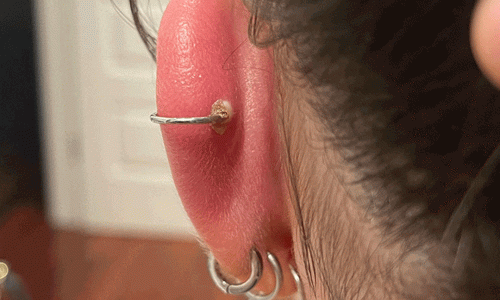Getting a piercing can be exciting. It allows you to express yourself. However, sometimes piercings can get infected. It is important to know the signs of infection. This way, you can treat it quickly. In this article, we will learn how to tell if a piercing is infected.

Credit: www.essentialbeauty.com.au

Credit: www.nhs.uk
What is a Piercing Infection?
A piercing infection happens when germs enter the skin. This can cause redness, swelling, and pain. Infections can happen in any piercing. This includes ears, nose, and belly buttons. It is important to watch for signs of infection.
Signs of an Infected Piercing
There are several signs to look for. If you notice any of these, your piercing may be infected.
1. Redness
Look at the area around your piercing. If it is red, this could be a sign. Redness can mean your body is fighting germs.
2. Swelling
If the area looks puffy, it may be swollen. Swelling often happens with infections. It can be uncomfortable, too.
3. Pain
Does your piercing hurt? Pain can be a sign of infection. A little discomfort is normal. But if pain gets worse, it is time to check.
4. Warmth
Touch the area around your piercing. Does it feel warm? Warmth can mean there is an infection. The body sends blood to fight germs.
5. Discharge
Discharge is fluid that comes out of the piercing. It can be clear, yellow, or green. If you see any discharge, take note. This can be a sign of infection.
6. Foul Odor
Sometimes, infected piercings can smell bad. If you notice a strange odor, pay attention. This can be a warning sign.
7. Fever
In some cases, you may feel sick. A fever can mean your body is fighting an infection. If you have a fever, see a doctor.
What Causes Piercing Infections?
Understanding how piercing infections happen can help you prevent them. Here are some common causes:
1. Poor Hygiene
Not keeping the piercing clean can lead to infection. Always wash your hands before touching it. Use gentle soap and water.
2. Unsterile Equipment
If the piercer does not use clean tools, infections can happen. Always go to a professional who follows safety rules.
3. Touching The Piercing
Touching your piercing with dirty hands can introduce germs. Avoid playing with or touching your new piercing too much.
4. Swimming In Dirty Water
Public pools, lakes, and oceans can have germs. Avoid swimming until your piercing heals.
How to Prevent Piercing Infections
Prevention is always better than treatment. Here are some tips to keep your piercing safe:
1. Clean Regularly
Clean your piercing every day. Use saline solution or witch hazel. Avoid alcohol or hydrogen peroxide; they can irritate the skin.
2. Avoid Touching
Keep your hands off your piercing. Touching can transfer germs. If you must touch it, wash your hands first.
3. Choose Quality Jewelry
Use jewelry made from safe materials. Look for stainless steel or titanium. Avoid cheap metals that can cause reactions.
4. Follow Aftercare Instructions
Always follow your piercer’s aftercare advice. This includes cleaning methods and how to care for your piercing.
5. Avoid Swimming
Stay out of pools, hot tubs, and lakes while healing. Germs in the water can cause infections.
6. Stay Away From Makeup And Perfume
Do not apply makeup or perfume near the piercing. These products can irritate the area.
What to Do If You Think Your Piercing Is Infected
If you notice signs of infection, take action. Here are steps to help:
1. Keep It Clean
Continue cleaning your piercing. Use saline solution or a gentle cleanser. This helps remove germs.
2. Avoid Changing Jewelry
Do not change your piercing jewelry while it is healing. Changing it can make the infection worse.
3. Consult A Professional
If you see signs of infection, see your doctor. They can give you advice on what to do next.
4. Use Warm Compresses
Apply a warm compress to the area. This can help reduce pain and swelling. Use a clean cloth soaked in warm water.
5. Take Over-the-counter Pain Relief
If you are in pain, take medicine like ibuprofen. This can help you feel better. Always follow the instructions on the label.
When to See a Doctor
Some infections need medical help. See a doctor if:
- The pain gets worse.
- You have a fever.
- The swelling spreads.
- You see a lot of discharge.
- You feel very sick.
Frequently Asked Questions
How Can I Tell If My Piercing Is Infected?
Look for redness, swelling, or pus around the piercing. Pain or warmth is also a sign.
What Are The Common Signs Of An Infected Piercing?
Common signs include discharge, bad smell, and increased tenderness.
How Long Does It Take For A Piercing To Get Infected?
Infections can occur within days or weeks after getting a piercing.
Can I Still Wear Jewelry If My Piercing Is Infected?
It’s best to remove jewelry to prevent further irritation and allow healing.
Conclusion
Knowing how to tell if a piercing is infected is important. Look for redness, swelling, and pain. If you notice any signs, take action quickly. Clean your piercing regularly and avoid touching it. If you think it is infected, consult a doctor. Remember, prevention is key. Always follow aftercare instructions to keep your piercing healthy.
Taking care of your piercing can help avoid infections. Enjoy your new piercing while keeping it safe!




